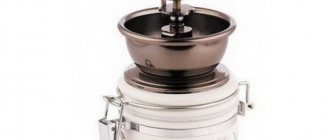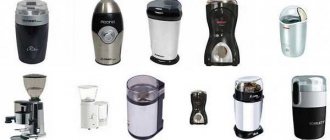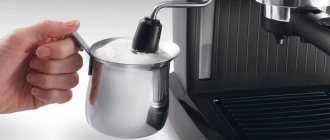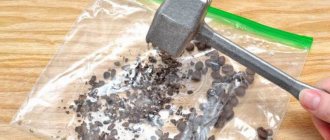Features of a burr coffee grinder
To prepare oriental coffee, it must be very finely ground. For these purposes, the first manual burr coffee grinder was invented in the 15th century. Inside such a device there are two millstones that grind coffee beans into powder.
A burr coffee grinder is designed for fine grinding.
The distance between the rings can be adjusted and you can get coffee of different grinds (from coarse to finer). Coffee grinder parts are made of cast iron or ceramics. Cast iron ones are strong and durable, while ceramic ones retain all the qualities and aroma of coffee well.
Form
Modern manual and electric coffee grinders use flat or conical burrs. The first are the classic standard. Some models have both types: flat-conical.
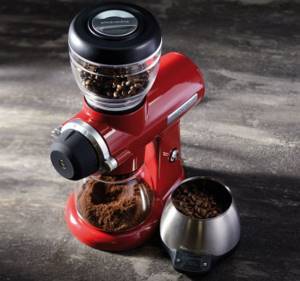
Coffee grinders are manual and electric.
Design
Flat millstones are two steel discs of the appropriate shape with one-sided notches (cutting edges) applied around the circumference of the disc itself. There are large holes in the center of both discs. Through a hole in the upper millstone, coffee beans enter the coffee grinder. The hole in the lower disk is used for attachment to the motor shaft.
During operation, one of the millstones is fixed, while the second rotates, grinding the grains.
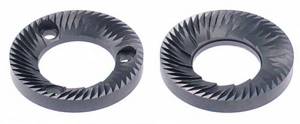
Flat burrs in a coffee grinder are used to coarsely grind coffee beans.
The holes for attaching the discs themselves directly to the coffee grinder body are located around the circumference. The electric motor starts the grinder grinder (hundreds of revolutions per minute), and very fast rotation occurs.
At the initial stage of grinding, the grains are crushed into large particles. This happens thanks to the blades located around the circumference of the millstones of the internal hole. After this, large particles of coffee beans move to the outer edges of the discs, where they are further crushed by small blades located on the outer circumference.
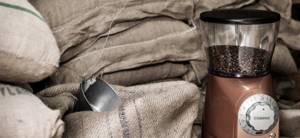
Manual coffee grinders use flat burrs.
During the grinding process, when the coffee is approximately equal to the distance between the outer edges of the burrs, it is pushed out of the side slot between the discs into a container or coffee brewing unit.
The most common and most progressive millstones on the market are conical millstones. They consist of a cone - this is a lower rotating disk and a funnel with cutting notches. Unlike flat millstones, these millstones have increased productivity and low noise levels. The ability to lower the speed allows you to reduce the heating of the coffee beans during the grinding process, which preserves the aroma much longer.
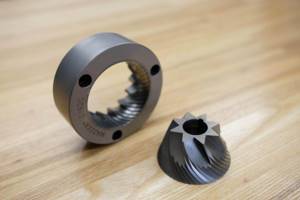
Conical burrs are used in coffee grinders more often than flat ones.
The principles and sequence of operation of conical millstones are the same as for flat millstones. The coffee beans are ground between the working surfaces as the lower disc of the coffee grinder rotates. Already properly ground coffee is pushed out at the bottom of the millstones.
Material
Coffee grinder burrs are most often made of high-carbon steel. In devices intended for heavy loads, parts are coated with various protective coatings that reduce wear. Even hardened, durable steel is subject to wear, but when titanium is applied, the millstones will become dense, smooth and will last for quite a long time.
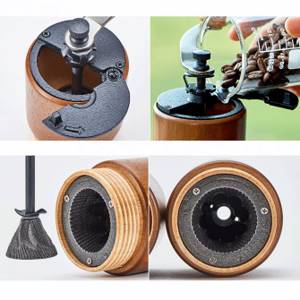
The grinders in the coffee grinder are made of titanium, which makes them last longer.
Such disks are used in professional machines for large volumes of work, and accordingly the device is expensive.
Although ceramic wheels are considered hard and retain the aroma of coffee beans, they are very sensitive to the ingress of excessively hard particles into the grinding zone; when overheated, they collapse and crack.
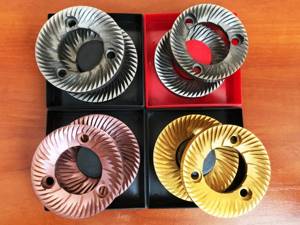
The material used to make millstones is varied. There are titanium, ceramic, stainless steel.
The best solution for 2021, according to experts, is the combination of ceramics with corundum - a durable, environmentally friendly alloy that can grind grains of any size and hardness. It is not afraid of dampness, water, rust, and does not absorb foreign odors.
The cheapest, with many positive reviews from consumers, are stainless steel millstones. They are quite wear-resistant, have average durability, and are great for regular use.
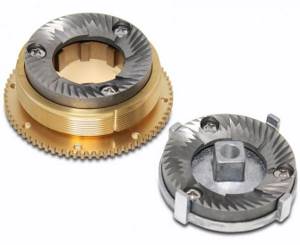
The simplest millstones for a coffee grinder are made of stainless steel.
Electric burr coffee grinder
There is an opinion that these devices were created primarily for professional use. In fact, it is very difficult to use a hand mill to process the amount of coffee necessary for the morning influx of visitors even in a small cafe. The electric coffee grinder has become a real salvation.
Then, as usual, the idea took hold of the masses, and the electric burr coffee grinder confidently stepped into our home kitchens.
The electric mill consists of a motor, millstones and two coffee containers. Their location and mobility are different in different models. For example, both or only one can be removed autonomously; containers can be located at different heights and even in different planes.
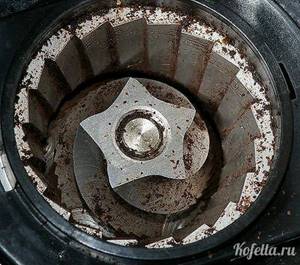
The grains intended for grinding are poured into one container.
Then turn on the coffee grinder.
Passing between two millstones, which can be conical or flat, the grains are ground and crushed.
The ground coffee is collected in a second container, from where it can be taken out and prepared without leaving the kitchen table.
IMPORTANT: You can place a large number of beans at once into the container of an electric burr coffee grinder, and then grind in the amount needed for one brew of coffee.
Advantages of an electric burr coffee grinder
- The best way to grind coffee beans. Grinding and crushing makes it possible to grind the beans as gently as possible, preserving the taste and aroma.
- Ensuring grinding uniformity. For example, grinding coffee to make espresso can only be done using a burr coffee maker, due to the maximum uniform size of the resulting particles.
- Possibility to select the required grinding fineness. In modern electric mills the number of grinding modes reaches up to 16.
- The ability to grind any selected amount of coffee beans in one go, from a few spoons to a whole pack.
- High grinding speed of a portion of coffee beans. The required portion will be ready very quickly, in 10-30 seconds.
- Saving not only time, but also effort.
When considering the option of purchasing a modern version of a burr mill, it will not be superfluous to know about the important factors that influence the choice of the optimal device for operation.
Defining parameters of an electric burr coffee grinder
- Type and material of millstones . By type, these important working parts are divided into conical and flat. The former work more slowly, but eliminate the possibility of burning the grain. Their service life is also much longer. Plane-parallel millstones provide higher productivity, but quickly become unusable. In addition, their high rotation speed can give the grain an unpleasant bitterness. The material of the millstones affects the life of the device. Stainless steel can process up to 500 kg of coffee, ceramics – up to 1000 kg.
- Possibility to adjust the degree of grinding . This function allows you to select the particle size of the finished product that is required for the recipe. Modern models of burr coffee grinders can produce from 8 to 16 grinding levels.
- Availability and type of timer . This device will help you calculate how many seconds it will take to grind a portion of coffee for a given amount of drink. The timer can count seconds or the amount of coffee ground. In the latter case, it will depict coffee cups. This version is convenient because you can simply set the number of cups for which you are preparing a portion, and then the machine will do everything automatically. As for the electronic or mechanical timer mechanism, this function can be selected solely according to the taste of the owner.
IMPORTANT: The duration of operation of the coffee grinder only affects the amount of the finished product. This factor does not affect the degree of grinding and the taste of ground coffee.
- Burr coffee grinder motor power . Affects performance. If you do not plan to set up a 24-hour cafe, then for home needs a power of 100-150 W will be quite sufficient.
- Volume and material of coffee containers . The container for grains is always slightly larger than for powder. Its volume can reach up to 300 grams. Preferred sizes depend on the owner's personal tastes and habits. Some people prefer to pour the entire packet of coffee into the container and then grind as needed. Containers are made from glass, metal or plastic. Glass is more fragile, but does not absorb odor and does not stain. Plastic is stronger and usually cheaper.
- Price . The cost of an electric burr coffee grinder, on average, ranges from 800 to 5,000 rubles, although there are much more expensive options that do not have any fundamental differences from their affordable counterparts, except for design and brand. The cost of devices varies depending on the manufacturer, year of manufacture, configuration and options.
- Additional features and accessories . These can be pleasant additions, in the form of a measuring spoon or a built-in dispenser. Sometimes options have a very significant impact on the quality of the final product. For example, the mark on the body of a coffee grinder “precision millstones” means that this device ensures maximum uniformity of any type of grinding. This has a positive effect on the taste of the finished drink. For absent-minded people or people who are always in a hurry, the additional function of protection against motor overheating may be useful. It simply turns off the system when the load is too heavy, and allows you to start the coffee maker until the engine cools down to an acceptable temperature.
IMPORTANT: When purchasing, you should pay attention to the ease of cleaning the device. The easiest way to maintain a coffee grinder is with removable containers.
Advantages and disadvantages
Now you can take a closer look at the specifics of the operation of each type of device separately, finding out what a burr coffee grinder is and how comfortable this equipment is for everyday use.
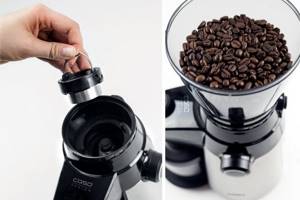
Manual coffee grinders are more budget-friendly.
Manual burr coffee grinder
A hand mill has metal or ceramic millstones, the grinding fineness of which is regulated by a special screw. The first millstone of the crushing apparatus rotates with the rotation of the coffee grinder handle, the second remains firmly fixed. The mechanics are durable, work independently of electricity, do not burn beans and allow you to get aromatic coffee. Significantly cheaper than electric ones. Indispensable for outdoor trips.
The disadvantage of a regular manual coffee grinder is that you need to spend time and physical effort of 5 minutes or more to grind coffee for one serving. Therefore, this unit is not applicable, for example, for an office.
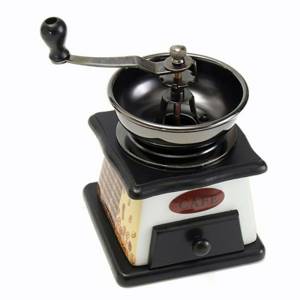
In a manual coffee grinder, a special screw is responsible for the fineness of grinding.
Electric burr coffee grinder
Popular brands offer more efficient electric burr coffee grinders that are distinguished by high-quality and uniform grinding. They do not require any effort or energy; you just need to press a button and the device will do everything for the user. This is a great solution for morning coffee or visiting guests.
It is very important that beans ground in burr-type coffee grinders are suitable for brewing in carob and other coffee makers and types of coffee machines.
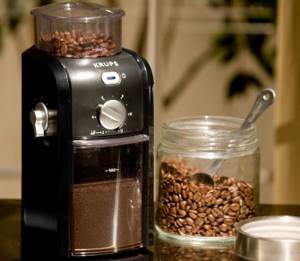
It has a more modern design, differs from manual grinding in higher quality.
Classification
Modern burr coffee grinders can be divided into two groups, which differ from each other in the type of design and operating principle.
In manual coffee grinders, the crushing apparatus is represented by two conical millstones. One is rigidly fixed, the other rotates if you twist the handle. The quality of grinding depends on the effort applied. Manual coffee grinders do not burn the raw material and allow you to adjust its fineness. Such a device is inexpensive, but to get powder for brewing one serving of coffee, you will have to turn the handle of the device for 1–5 minutes, depending on the required grinding fineness.
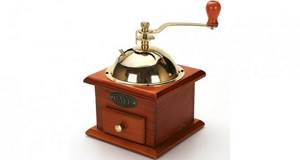
Electric burr grinders resemble hand mills, but are electrically driven. The structure consists of an engine, a millstone and two containers. Grains are poured into one, they pass between the millstones, are ground, crushed and poured into the second container. You can pour in a lot of raw materials and grind as much as is required for several servings of the drink. The device works quite quickly and allows you to get aromatic powder for one cup in 10-30 seconds.
Electric coffee grinders allow you to get better and more uniform grinding than manual ones. In this case, the process takes place with less time and effort. But when choosing a device, you need to study its technical characteristics in order to understand whether such a device is suitable for your purposes and whether it will be convenient to handle.
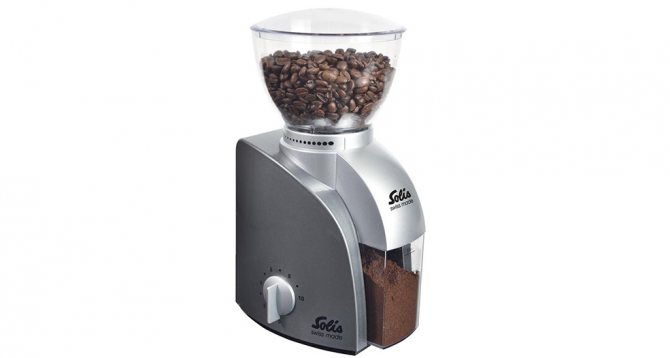
The working principle of burr coffee grinders
A distinctive feature is the presence of two containers. One is filled with grain, the other is filled with already ground coffee. This is very convenient when grinding small portions.
Burr coffee grinders allow you to achieve uniform grinding. In some models, you can select the grind size necessary to obtain a certain taste and aroma inherent in the characteristic varieties of coffee. The selection of parameters is made on the touch panel.
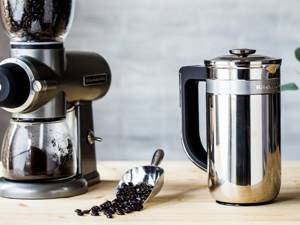
The principle of operation of a coffee grinder is to grind beans for further use.
The operating principle of this type of coffee grinder consists of the following steps:
- Whole coffee beans, falling into the millstones, are ground during the operation of the coffee grinder mechanism and turned into powder of varying densities;
- adjusting the distance between the rings allows you to choose a larger or finer grinding particle size; this is very important, since each type of coffee has its own optimal density, which affects the subtleties of the characteristic taste and smell.
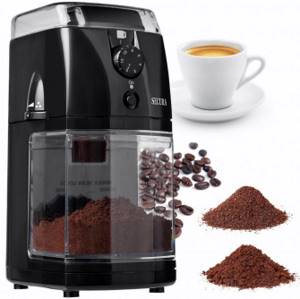
An electric coffee grinder has several grinding modes.
Manual burr coffee grinder
A manual burr coffee grinder is something of a cult item for lovers of real coffee. The process itself turns from a utilitarian function into a kind of sacred rite. The measured rotation of the handle, the barely audible creaking of the millstones, the thick and spicy aroma in the air - as soon as you imagine such a picture, the question of which coffee grinder to buy disappears by itself. Of course, manually!
Advantages of a manual burr coffee grinder
- Gentle processing of coffee beans. The method of grinding grains ensures maximum preservation of their taste.
- There is no danger of burning the coffee beans during processing.
- Possibility of adjusting grinding fineness.
- Availability of a container for ready-made ground coffee.
- Low cost.
IMPORTANT: In order to grind a portion of coffee for one cup of coffee, it will take from 1 to 5 minutes, depending on the required grinding fineness, so calculate your strength in advance.
Although the history of the manual burr coffee mill is lost somewhere in the centuries, it has not changed much over time. Perhaps it changed a little in appearance, and parts began to be made from modern materials. The main design features of a manual coffee grinder developed many centuries ago. What does the average user need to know about them?
Defining parameters of a manual burr coffee grinder
- Housing design . The most common today can be called three types: European, Turkish, modern (unframed). The first has a cubic shape, a retractable container for the finished powder. When working, be sure to stand on a hard surface. The eastern type is more like an elongated cylinder, decorated with carvings or chasing. The ground coffee container is smaller and the bean cone is always closed. When grinding, the Turkish mill is held in the hand. The frameless hand mill is characterized by the absence of a container for the finished powder. Coffee is poured into the vessel on which the device is installed. Externally, a frameless coffee grinder resembles a stepped funnel with a handle on top.
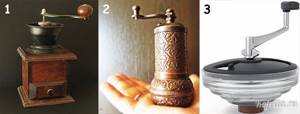
- Millstone material . The conical burrs of a manual coffee grinder can be cast iron, stone, ceramic or stainless steel. Cast iron - cheap, durable, reliable, but porous, quickly absorbs odors and tastes. Due to the friability of the metal, microscopic particles can get into the ground coffee and give it an unpleasant taste. Stainless steel is the most common material in the mass production of manual coffee grinders. Stainless steel millstones are inexpensive, durable, but wear out faster than those made from other materials. Sometimes such millstones are coated with titanium, this makes them much more expensive, but stronger and more durable. The ceramic version lasts a long time, providing very high quality grinding. Such millstones remain sharp for a long time and grind even better than metal ones. Their biggest drawback is their fragility; they break easily. Stone millstones are almost ideal, although they are much more expensive.
- Method for changing grinding fineness . There are two options for implementing this function. The step method is implemented in European and frameless coffee grinders. You can change the size of the ground coffee particles by moving the rotation control of the movable shaft. For oriental type mills, just turning the fastening screw on the handle is enough to change the size of the ground coffee particles.
- The location of the handle relative to the body . The lateral arrangement is typical for European-type hand mills. The handle on top can be found in any variant.
IMPORTANT. The choice of the most convenient location of the handle is always individual, so to determine your own preferences, simply twist the handle for 1-1.5 minutes.
- Volume and design of the grain container . Various options hold from 10 to 200 grams of coffee beans, and their design can be open or closed with a lid. All Turkish coffee grinders are equipped with closed containers for beans, this makes their operation quieter and allows the coffee to retain its precious aroma. In recent years, other types of hand mills have increasingly been supplied with closed containers, but for the European type, open containers are still actively used.
IMPORTANT. Choose the volume of the container based on the calculation of the usual one-time serving of the drink. It is impossible to store grain and grind it as needed in a manual mill, and a container that is too large makes the coffee grinder too bulky.
- Price . The simplest hand mills are in the price category from 450 to 900 rubles. In the range from 1000 to 3000 you can buy a very decent model with ceramic millstones. The category from 5,000 rubles refers to branded ones, but you should pay attention to it only if you decide to definitely buy a coffee grinder with stone millstones.
You can choose the material for making a manual burr coffee grinder according to your taste from a long list: copper, stainless steel, plastic, wood, porcelain, ceramics.
Main characteristics when choosing
When choosing a coffee grinder, the main factors are the millstones, their type and material, grinding adjustment, the presence of a timer, containers, ease of cleaning the device and price.
Power
The engine power of the device is of great importance - because it affects performance and durability. The numbers for home coffee grinders are from 100 to 170 W. For heavily roasted and strong beans, professional devices with ratings from 150 to 180 W are used.

When choosing a coffee grinder, you should take into account the power, grinding modes, and additional options.
Limitation of grinding time and amount of powder
These characteristics are adjusted using a timer. It is set to a specific number of seconds for a specific number of cups of coffee being prepared.
Timers can be mechanical or electronic. Which choice is better is a matter of principle. It all depends on taste and financial capabilities. Models with an electronic timer are more expensive.
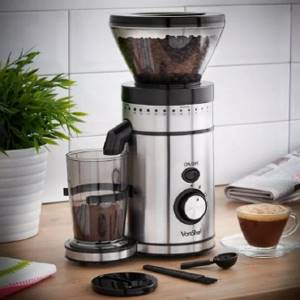
Everyone chooses a coffee machine for themselves.
Type of millstone
Millstones are made of stainless steel, ceramics, alloy (ceramics + corundum) stone. The material from which the rings are made affects the durability, uniformity and quality of grinding of coffee beans, as well as its taste.
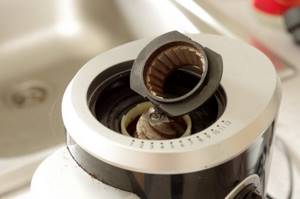
When choosing millstones, it is worth buying higher quality materials; their shelf life depends on this.
An important point when choosing millstones:
- the durability of metal discs is comparable to grinding 250-500 kg of coffee;
- When used correctly, ceramic rings can grind up to 1000 kg of coffee.
After these resources have been exhausted, it is necessary to replace the millstones with new ones by ordering them at the service center. Otherwise, the coffee grinder will not be able to please you with the excellent grinding quality, which in turn will affect the taste of the drink.
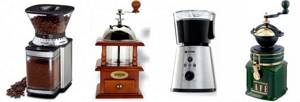
Electric coffee grinders work faster and better than manual ones.
Millstone material
Burr coffee grinders are very rare and expensive. Mostly they contain stainless steel rings. What millstones are still used in coffee grinders are described at the beginning of the article. In any case, the choice remains with the buyer.
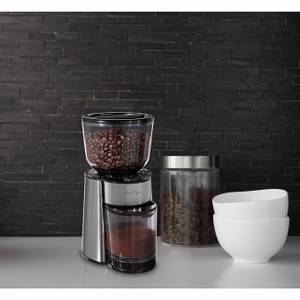
Usually, the materials chosen for coffee grinders are expensive and durable.
Adjusting the grinding degree
This parameter directly depends on the client’s preferences. When preparing in a French press, the coffee particles must be fairly large. When brewing espresso, medium grind particles are suitable. If the client loves oriental or Turkish coffee, the lightest type (dust) is best.
It is very important, if possible, to understand in the store all the intricacies of the work from coarse to fine grinding. Therefore, you should not purchase the device via the Internet. It is worth looking for the most convenient and simple adjustment option. An excellent choice would be to purchase a coffee grinder with precision burrs.
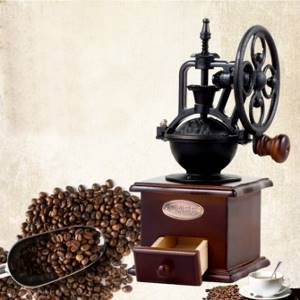
There is no adjustment of the degree of grinding in manual coffee grinders.
Easy to clean
Few buyers pay attention to this criterion, but they are well aware of it some time after the purchase. Some people don't even realize that cleaning a coffee grinder can be a very difficult task. They mainly clean millstones and containers for beans and coffee powder.

The coffee grinder needs to be cleaned regularly.
Sequence of the cleaning process.
- You need to unscrew the bean container, remove the powder container and rinse.
- Unscrew the screws that secure the millstones, carefully remove them and clean them with a brush and wipe with a napkin.
- Carefully reassemble everything in reverse order.
When purchasing, you can ask the seller to help - show the cleaning process. This way you can see how difficult it is.
Important! Do not wash the millstones with water!
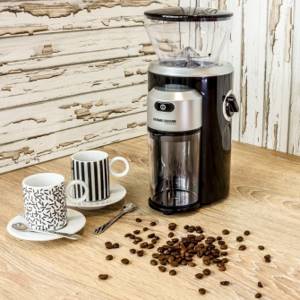
Coffee lovers prefer to have a cup of the brewed drink for breakfast.
Additional options
When choosing a device, it is advised to pay attention to the following details.
- The capacity of the containers and the material from which they are made. The best option is glass. They are not static and do not absorb odor.
- Function of automatic shutdown of the device motor when clogged.
- Locking the device when the cover is open.
- Motor protection and device shutdown in case of overheating and overload.
- Slotted legs are a very useful little thing that will help secure the equipment while working so that it does not move around the table.
- Templer - for compacting “pods” (so-called coffee tablets).
- Cord compartment.
- Cooling Fan.
- Increased sound insulation.
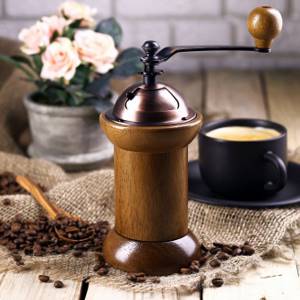
Manual coffee grinders have an interesting and intricate design.
Main characteristics that you should pay attention to when choosing
There are no difficulties in choosing hand mills for grinding beans. But you need to take into account the material used to make the millstones and the capacity of the container. The crushing apparatus of the coffee grinder is represented by conical elements, which grind the raw materials when the handle is turned. Processing time takes several minutes depending on the desired grinding fineness. When choosing an electric household appliance, you need to take into account the power of the device, bean grinding modes, design and material of the millstones.
Power
The performance of a burr coffee grinder depends on the power of the device, which ensures the speed of operation of the device and affects the cost of kitchen appliances. The higher the power rating, the easier the hard coffee beans are to process. For household appliances, the optimal power parameter is 100-300 W; on an industrial scale, 600 W burr grinders are used. For grinding coffee at home, a conical burr coffee grinder with a power of 180 W is suitable. This will allow you to grind grains quickly and save energy.
Limitation of grinding time and amount of powder
Using a timer simplifies the process of grinding beans with an electric burr grinder. The device can count how long it takes to grind a portion of coffee, or the timer can be set to count the amount of ground material. There are three types of timers:
- Electronic.
- Mechanical.
- Seconds.
Some people find it easier to count the number of cups, while other gourmets choose to count their coffee by the second. Which device you prefer is a matter of taste, but you should pay attention that models with an electronic timer are more expensive. Some coffee grinders are equipped with the option to select portion dosages, for example, from 4 to 12 cups. This is convenient for preparing coffee according to different recipes.
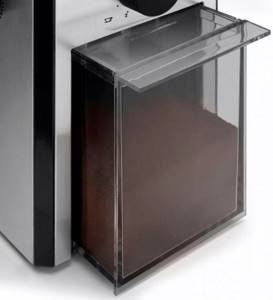
Type of millstone
Based on the type of crushing apparatus, there are coffee grinders with conical and cylindrical (plane-parallel) millstones. Both options provide uniform grinding of grains, but have different characteristics. The service life of crushing fragments varies, so when choosing, you need to pay attention to the type of millstone:
- Conical elements - a stationary outer cone and a rotating inner millstone. When ingested, the beans are ground due to the high rotation speed. The ground particles are poured into a container. Using a conical burr grinder reduces the chance of overheating. The devices last longer, operate almost silently, and the millstones have the required strength.
- Cylindrical or plane-parallel millstones resemble washers, the edges of which are connected by notches. After turning on the equipment, the grain falls onto the discs, and the millstones grind the beans. Screening of raw materials occurs when the size of the fractions becomes less than the distance between the washers. The discs operate at high speed, the noise level is pronounced, and as a result of constant use, the millstones are more likely to fail.
Important! Plane-parallel millstones have high performance against conical elements. But the mechanism wears out faster and eventually requires replacement - you can purchase plane-parallel washers for repair from branded manufacturers with an extensive service network.
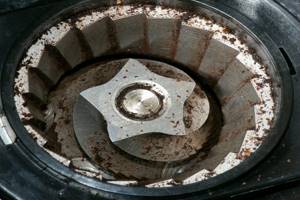
Millstone material
The main working mechanism of a coffee grinder is the millstone. The service life of the device depends on the quality of the material from which the crushing fragments are made. When producing products, manufacturers equip coffee grinders with millstones made of steel, cast iron, ceramics, and durable alloys. Characteristics of different materials:
- stainless steel. It has optimal strength, wear resistance, and durability. Disadvantage: instability to moisture;
- cast iron. Inexpensive, durable material for making millstones for hand-held instruments. After prolonged use, ground coffee acquires a metallic taste;
- hardened steel with titanium coating. The material is used for millstones in professional coffee grinders. Has great strength and service life;
- stone. To strengthen the millstones, an alloy of ceramics and corundum is used. Using a coffee grinder with ceramic millstones ensures uniform grinding, long service life, and any grind size.
The service life of metal parts is 250-500 kg of coffee beans, ceramic crushing elements are about 1000 kg of beans. Pure ceramic millstones are as hard as diamonds, but are brittle. The grinding elements work for a long time if the device is handled carefully. Ceramics are not afraid of moisture and do not absorb foreign odors, which is very important for making ground coffee.
The best option is to purchase a coffee grinder with stone millstones (ceramics plus corundum). Such devices are less common on sale and have a high cost, but the stone grinds the grains to the smallest powder.
Adjusting the grinding degree

The fineness of grinding the coffee beans determines the recipe and method of preparing the drink. A burr coffee grinder with adjustable grinding degree is most convenient for home and professional use. The grinding speed depends on the engine speed with which the electric mill is equipped. What to consider when choosing grind fineness:
- A slider or ring helps control the degree of grinding of the beans.
- The instructions for the coffee grinder should indicate the uniformity of grinding.
- The standard number of grinding levels depends on the model of the device.
- The required size of fractions is achieved by changing the distance between the millstones.
To adjust the grinding device to the required fineness, take into account your own tastes. To prepare espresso, beans are ground into medium-sized fractions. To brew a cup of Turkish coffee, the beans are ground into a fine powder.
Attention! The inscription on the coffee grinder “precision millstones” means that the device provides high grinding accuracy with almost one hundred percent uniformity of fractions. The output is more raw materials of the same size.
Easy to clean
Daily grinding of coffee requires cleaning the device at least once a month. Not every buyer thinks about how convenient it is to clean a coffee grinder. Therefore, it is worth asking the seller to disassemble and reassemble the mill. Removable containers simplify the process of cleaning the device; odors and types of coffee do not mix in them.
If the container cannot be removed, you need to check whether it can be completely cleared of the remaining ground raw materials. Caring for the coffee grinder: unscrew the screws holding the millstones, clean the crushing mechanism with a special brush (may be included in the kit). It is not recommended to wash the millstones to prevent them from rusting. Before purchasing a mill, you need to check the tightness of the containers to the coffee grinder body.
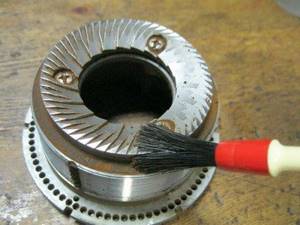
Coffee grinder grinders require maintenance and periodic cleaning
Additional options
When choosing a device for grinding coffee, you should pay attention to the material of manufacture and the capacity of the containers. Metal containers are stronger than plastic dispensers. Glass containers are the best option; they do not absorb odors and do not “collect” static electricity. Operating modes of devices:
- Automatic shutdown when clogged.
- Block with the cover open/removed.
- Protection against engine overheating during overload.
As a nice touch, the coffee grinder may come with a measuring spoon for dosing powdered raw materials. Devices with rubberized legs are more stable and will not fall off the table during the chopping process. Some models have a cord compartment where you can easily store excess cord.
Instructions for use
Any coffee grinder should come with clear instructions telling you how to use the device correctly. The content of the instructions may vary, but the general meaning is the same for all electric mills:
- Check the network disconnection.
- Place bean container.
- Push in the ground coffee container.
- Add grains according to dosage.
- Close the container tightly with the lid.
- Turn on the device and select the grinding fineness.
- Press start, start grinding.
- Turn off the coffee grinder and take out the ground coffee.
When using a manual mill, manipulation consists of pouring beans and grinding coffee beans by rotating the handle. It takes more time, but the result is worth the effort. The most aromatic, delicious coffee comes from hand-ground beans.
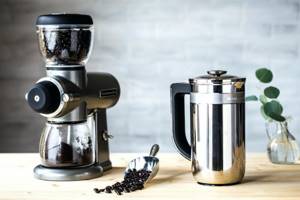
Popular models of burr coffee grinders
The choice of devices for processing coffee is impressive - many manufacturers of kitchen utensils and household appliances offer models of coffee grinders to suit every taste and budget. The design, characteristics, performance, and functionality of the devices differ. Models from Bosch, Caso, De`longhi, Braun Moulinex, Tefal, Polaris, Scarlett, Vitek, Siemens, Krups Aresa and other brands are in constant demand. A brief overview of the best burr coffee grinders in an affordable price segment:
- Delonghi KG 89. European quality device with a metal case, double protection system, automatic shutdown option. It is enough to set the number of desired cups, and the coffee grinder will select the required amount of coffee;
- VITEK VT-1548. The sample is easy to use, contains four grinding modes, has compact dimensions, and a nice design. The resulting raw material is characterized by good uniformity of fractions. The engine and millstones are protected from overheating;
- Bekker GVX 242. Universal electric mill with optimal power. Provides good grinding quality for different coffee brewing recipes. There is a block for working without containers, portion control.
There is no consensus which models of burr coffee grinders are more suitable for home use - electric or manual. Electrical devices are preferred by people with limited free time. Manual coffee grinders are a tribute to tradition. In terms of productivity, hand mills are inferior to modern kitchen gadgets, but the process of making coffee does not lose its charm, and the drink retains its taste, strength and delicate aroma.
Useful tips for choosing
To summarize, we can note some features that you need to pay attention to when choosing a coffee grinder:
- Millstone type;
- the material from which the rings are made;
- engine power;
- volume of containers;
- ease of cleaning.
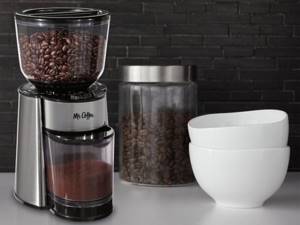
Research the market before purchasing a coffee grinder.
For espresso coffee lovers or those who like to make coffee in a geyser coffee maker, a burr coffee grinder will be an indispensable assistant. Some of them have 14 grind levels and hold 250-300 grams of coffee!
Which is better: a manual or electric burr grinder?
As usual, there is no definite answer, and probably cannot be.
An electric mill is faster, more convenient, more functional. However, it is more expensive, dependent on the power source, and takes up more space in the kitchen.
A manual burr coffee grinder is more compact, simpler, can be used anywhere, and is usually cheaper. But it requires more time and effort to grind a portion of coffee, and does not have the additional options of a modern electric device.
As practice shows, electric coffee grinders are preferred by active people who are passionate about modern gadgets, as well as those who are sorely short of time.
Hand mills find their way into the homes of those who appreciate natural taste, handicraft, and for whom preparing their favorite drink is a certain ritual.
Most often, both options coexist peacefully in the kitchen of real coffee fans. The electric one is intended for weekdays, and the manual one is reserved for the weekend, when you can relax and reward yourself with a leisurely, thoughtful preparation of a cup of real coffee.

